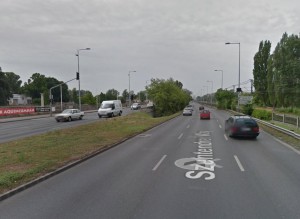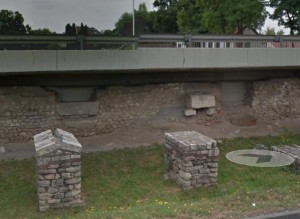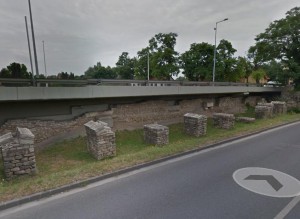Grated windows
Next up: the second post in our blog about what we can see while sitting in traffic if we decide not to just stare ahead and speculate about the ancestors of that pushy motorist in front of us.
Last time we looked at the remains of the Roman aqueduct between the two lanes of Szentendrei Road. If we pay close attention, between the pillars we can also see signs of a different sort of building.
So where are we now?
We’re heading south along Szentendrei Road and pass the Aquincum HÉV stop and the Budapest-Esztergom railway bridge. About 170 metres after the first reconstructed section of the aqueduct, looking between the pillars and just below the road’s concrete structure, we can see the building in question. It’s none other than the rear wall of the long row of shops.
But first the history!
The long row of shops, or tabernae lay south of the Aquincum Civil Town’s forum, along the main road leading towards the legionary fortress (around modern-day Flórián Square). Most of this ancient ‘shopping centre’ is now under the outbound lanes of Szentendrei Road, but its rear wall reaches the line of the aqueduct. The shops, all roughly 6 m wide, had an upper storey and at least two rows of rooms. They opened from the main north-south road, now in the museum’s archaeological park, where today we can only see a short section of the tabernae’s front rooms. Shops’ entrances had almost full-length stone thresholds and could be closed for the night with plank doors. The building, its shops and the ground level were altered several times between the 2nd and 4th centuries. Finds indicate that the shops sold – among others – local pottery, lamps, and terracotta figurines and that a money changer also operated there. Finds from one of the shops are particularly noteworthy: they suggest the shop primarily sold fine imported wares (terra sigillata) from the western provinces.
What can we see today?
The outer rear wall of the tabernae to the west lay along an alley, just behind the pillars of the aqueduct. The walls and stone-framed windows of the shops’ stockrooms are still clearly visible. The remains were so well preserved that during the first excavations the iron grating of the windows was still in place.
Soon we’ll continue our search for Roman remains as there are still plenty of other hidden and conspicuous monuments to discover; but more on those later.
All in all, I encourage everyone to have a look at the stone-framed windows on foot (for the best view), or from the warmth of your car on a cold morning – but only when the traffic isn’t moving!
Images from: Google Street View
Dániel Kővágó





